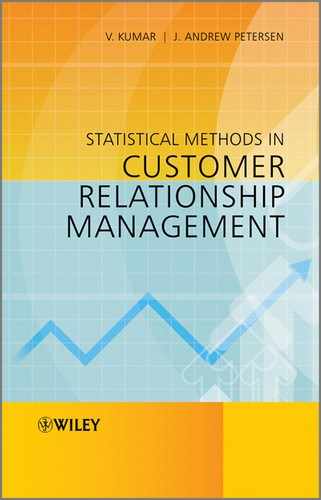C.1 Unit-Root Testing: Are Performance and Marketing Variables Stable or Evolving?
The distinction between stability and evolution is formalized through the unit-root concept. Here, a simple case where the behavior over time of the variable of interest (e.g., a brand's sales ![]() ) is described by a first-order autoregressive process:
) is described by a first-order autoregressive process:
where ![]() is an autoregressive parameter,
is an autoregressive parameter, ![]() the lag operator (i.e.,
the lag operator (i.e., ![]() ),
), ![]() a residual series of zero-mean, constant-variance
a residual series of zero-mean, constant-variance ![]() , and uncorrelated random shocks, and
, and uncorrelated random shocks, and ![]() a constant. Note that Equation (C.1) may also be written in the more familiar form
a constant. Note that Equation (C.1) may also be written in the more familiar form
(C.2) ![]()
which corresponds to a simple regression model of ![]() on its own past, with
on its own past, with ![]() the usual i.i.d. residuals. Applying successive backward substitutions allows us to write Equation C.1 as
the usual i.i.d. residuals. Applying successive backward substitutions allows us to write Equation C.1 as
in which the present value of ![]() is explained as a weighted sum of random shocks. Depending on the value of
is explained as a weighted sum of random shocks. Depending on the value of ![]() , two scenarios can be distinguished. When
, two scenarios can be distinguished. When ![]() , the impact of past shocks diminishes and eventually becomes negligible. Hence, each shock has only a temporary impact. In that case, the series has a fixed mean
, the impact of past shocks diminishes and eventually becomes negligible. Hence, each shock has only a temporary impact. In that case, the series has a fixed mean ![]() and a finite variance
and a finite variance ![]() . Such a series is called stable. When
. Such a series is called stable. When ![]() , however, Equation C.3 becomes
, however, Equation C.3 becomes
(C.4) ![]()
implying that each random shock has a permanent effect on the subsequent values of ![]() . In that case, no fixed mean is observed, and the variance increases with time. Sales do not revert to a historical level, but instead wander freely in one direction or another, that is, they evolve. Distinguishing between both situations involves checking whether the parameter
. In that case, no fixed mean is observed, and the variance increases with time. Sales do not revert to a historical level, but instead wander freely in one direction or another, that is, they evolve. Distinguishing between both situations involves checking whether the parameter ![]() in Equation C.1 is less than or equal to 1.
in Equation C.1 is less than or equal to 1.
Numerous tests have been developed to distinguish stable from evolving patterns. One popular test, due to Dickey and Fuller [2], is based on the following test equation:
(C.5) ![]()
The t-statistics of ![]() are compared to critical values and the unit-root null hypothesis is rejected if the obtained value is larger in absolute value than the critical value. The
are compared to critical values and the unit-root null hypothesis is rejected if the obtained value is larger in absolute value than the critical value. The ![]() terms reflect temporary sales fluctuations, and are added to make
terms reflect temporary sales fluctuations, and are added to make ![]() white noise. Because of these additional terms, one often refers to this test as the ‘augmented’ Dickey–Fuller (ADF) test. Villanueva et al. [3] used the ADF test with the null hypothesis of unit root. For the key decisions to be made when implementing ADF-like unit-root tests, readers may refer to Dekimpe and Hanssens [1] for details.
white noise. Because of these additional terms, one often refers to this test as the ‘augmented’ Dickey–Fuller (ADF) test. Villanueva et al. [3] used the ADF test with the null hypothesis of unit root. For the key decisions to be made when implementing ADF-like unit-root tests, readers may refer to Dekimpe and Hanssens [1] for details.
